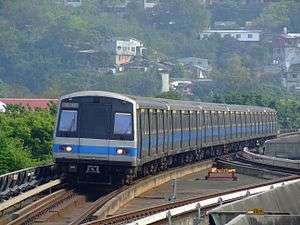Taipei Metro C301
| Taipei Metro C301 | |
|---|---|
 A Taipei Metro C301 train on the Tamsui Line. | |
|
Interior of the (unrefurbished) motor car of a C301 train | |
| In service | 28 March 1997–present |
| Manufacturer |
Kawasaki Heavy Industries and Union Rail Car Partnership |
| Built at | Yonkers, New York, USA |
| Constructed | 1992–1994 |
| Refurbishment | 2011–2013 |
| Number built | 132 vehicles (22 sets) |
| Formation | 3 x 2–cars per trainset |
| Fleet numbers | 001–044 |
| Capacity | 1914 passengers |
| Operator(s) | Taipei Rapid Transit Corporation |
| Depot(s) | Beitou |
| Line(s) served | Tamsui–Xinyi line |
| Specifications | |
| Car body construction | Stainless Steel |
| Car length | 23.5 m (77 ft) |
| Width | 3.2 m (10 ft) |
| Height | 3.6 m (12 ft) |
| Maximum speed |
Design: 90 km/h (56 mph) Service: 80 km/h (50 mph) |
| Weight |
39.5 t (DM1/M2) 34 t (T) |
| Traction system |
Original: GTO-VVVF (Westinghouse Electric) Current: IGBT-VVVF (Bombardier MITRAC 1000) |
| Electric system(s) | 750 V DC Third rail |
| Safety system(s) | ATC (ATO), ATS |
| Track gauge | 1,435 mm (4 ft 8 1⁄2 in) standard gauge |
The Taipei Metro C301 is an electric multiple unit train car, and was the first of its kind to be used on the heavy-capacity lines of the Taipei Rapid Transit System.
History
The Tamsui Line began operations on 28 March 1997 with a total of 22 C301 cars built from 1992 to 1994 by the Union Rail Car (URC) Partnership at a cost of $170 million USD.[1][2][3] The train cars were produced in the 150,000-square-foot (14,000 m2) Yonkers Plant in New York,[4] the first elevator factory in the world.[2] They were also the first train cars to be built at the plant for export.
Interior Design
The interior of the C301 contains seats arranged in both linear and latitudinal formations. There are priority seats and wheelchair spaces for those requiring special accommodations. In case of emergencies, fireproofing materials allow the C301 to withstand any fire for up to 45 minutes. Train announcements and next station information are displayed on LED information systems at the front of each car. The destination and line color are displayed on the exterior of the car.
Serial Number
Each car is assigned its own four-digit serial number, which ranges from x001 to x044.
- The first digit (the 'x' above) depends on whether the car is the first, second, or third car from either end of the train. The first car on either side has a 1, the second car has a 2, and the third car has a 3.
- The other three digits are the identification number of the train the car is part of. A full-length train of six cars consists of two identification numbers, one for the first three cars, and another for the second three. The bigger number is always equal to the smaller number plus one, and the smaller number is always an odd number. For example, a train of six cars would have serial numbers 1001, 2001, 3001, 3002, 2002, and 1002, respectively.
- Taipei Metro names train set numbers such as 01/02, 03/04, etc. instead of 001/002, 003/004, etc. (The numbers on the stickers near the driver's doors are only 2 digits long.)
Refurbishment
From 2011 to 2012, the C301 cars underwent refurbishment, and were fitted with new air-conditioning, surveillance, and fire detection systems. The original wood-style flooring was replaced with mostly white flooring, and the previously red LED in-train information systems were replaced with new LED in-train information systems. The first 11 C301 trains also received new IGBT-VVVF propulsion systems from Bombardier Transportation in 2013.
Train set 013/014 had been previously split and modified to serve as 3-car formations on the Xinbeitou Branch Line. When new 3-car formation C371 cars were made, train set 013/014 was subsequently re-joined and put back into normal service on Tamsui–Xinyi line. Train set 013/014 is also equipped with IGBT-VVVF inverters.
In 2017, the latter 11 sets are fitted with IGBT-VVVF inverters, effectively retiring all GTO-VVVF inverters.
See also
References
- ↑ 川崎重工業時代1969年(昭和44年) Archived 2010-03-26 at the Wayback Machine., Kawasaki Heavy Industries, retrieved 6 April 2008 (in Japanese)
- 1 2 Rail Car Plant In Yonkers Seeks $1 Billion Contract, The New York Times, James Feron, 17 January 1988
- ↑ Yonkers plant produces first Taipei cars - Union Rail Car Partnership gets $170 million contract - Brief Article, Railway Age, October 1992
- ↑ Made in the U.S. - and Japan - Japanese-owned Union Rail Corp. assembles rail cars in the US with Japanese shells, William C. Vantuono, Railway Age, July 1993